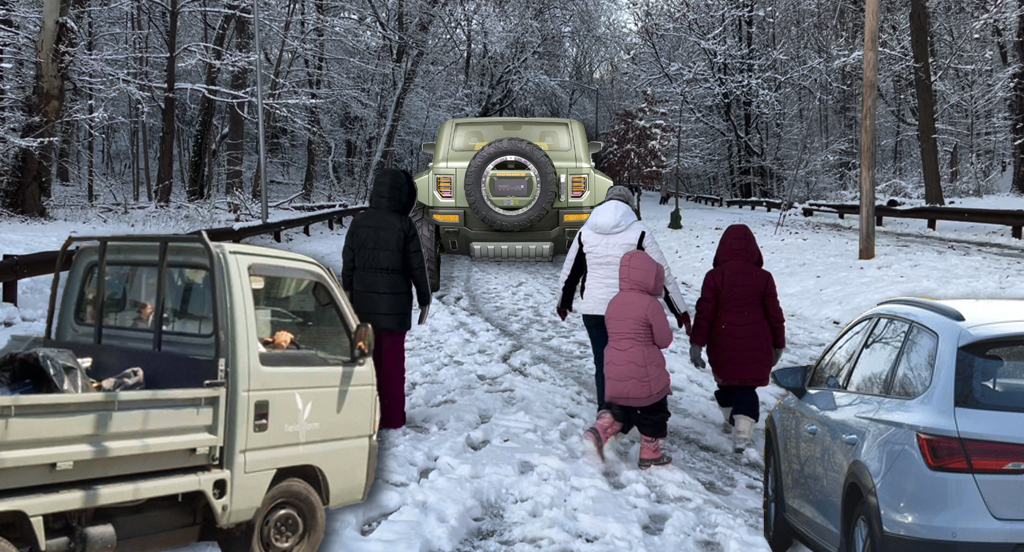Peter Fleischer is the executive director of Empire State Future, a coalition of 39 business, civic, and environmental organizations advocating for smart growth across New York state.
Over four hundred New York Thruway miles from Manhattan, in a corner of the state as remote as the Outer Banks of North Carolina or Acadia National Park in Maine, the 900,000-odd residents of Erie County float on a $1,100 per capita cushion largely provided by the taxpayers of downstate New York. According to Bruce Fisher, formerly the Deputy Erie County Executive and now the Director of Economic and Policy Studies at Buffalo State, Erie County takes in over one billion dollars more in state revenue and transfer payments than it pays in taxes to New York State.
 From 1951 to 2000, the population of metro Buffalo stayed flat, but land development sprawled out over an area three times as large. Click here to enlarge. Graphic via Joe the Planner
From 1951 to 2000, the population of metro Buffalo stayed flat, but land development sprawled out over an area three times as large. Click here to enlarge. Graphic via Joe the PlannerBuffalo, Erie County's largest city, needs that cash; it has been hemorrhaging jobs, residents and wealth for 50 years. Tonawanda, Lackawanna and Cheektowaga, great names really, Erie's other older industrial communities have begun to shed people too. Erie County is now losing both city-dwellers and suburbanites, even as new, far-flung suburbs grow at the regional periphery, eating up acres and acres of what were forest, field, wetland and family farm while cannibalizing its denser neighboring cities and towns.
It’s a sad and ongoing story -- akin to a publicly supported pyramid scheme with way too few new arrivals, just the same sources of funds, divvied up among fewer and fewer folks, folks who are living on more and more land, less and less efficiently, all the while needing ever more infrastructure and services to float on the cushion to which they have become accustomed.
And Erie is hardly the only upstate county where the fiscally and demographically absurd passes for near normal. Places like Oneida County, Broome County, Onondaga County and Niagara County are living on the same fiscal edge, losing residents year after year, from both city and suburb.
And yet they sprawl. In Monroe County, a charming place with 700,000 people (half the population of the Bronx), the rate of land development disproportionately exceeds the rate of population growth. And today’s upstate sprawl is not your father's sprawl. It is not an aesthetic blight of generic neon strip malls, "ginormous" parking lots and roadways with so many turning lanes that young athletes are deterred from crossing.
Well, okay, it is all that, but it is far worse than that. Because today's sprawl is too often built with public debt that allows upstate developers to build big houses on large lots in what were, till yesterday, green fields.
My friend George in Clarence, a very pretty rural Erie County suburb a score of miles from downtown Buffalo, says his town is the kind of place where one uses a gallon of gas to go get a gallon of milk. It’s hard to believe. But I ran the numbers. Upstaters tend to drive old American cars that get 12, 14 maybe 16 miles to the gallon. It’s not uncommon, in rural or even suburban upstate, to live five, six, or seven miles from the nearest town or gas station that sells stuff like milk.
Do the math -- a gallon for a gallon, crazy stuff. Watch out when that gallon goes back to $4.20 as it was in July 2008. The average upstate household (median income $43,000) has two cars, an old heating system with sub-standard insulation, and expensive oil-based electricity. That all-in energy bill can hit $7-8,000 per year. That's a big chunk of $43,000 before taxes. And there's no choice about it, one has to heat and one has drive. Everywhere. That's how upstate is set up. At least, that's how it is now after a couple of generations of sprawl and the resultant abandonment of cities where dense, efficient living is possible.
Statistics tell us that the upstate New York counties are in deep trouble. A recent study of demographics from Cornell University's College of Human Ecology projects massive drops in the population of almost all the upstate counties (Saratoga and Ontario are among the exceptions) over the next 25 years.
The big six western and central New York counties -- Erie, Niagara, Monroe, Onondaga, Broome and Oneida -- will lose a total of 340,000 people out of a combined 2010 population of 2.6 million. Losses like those happening in our upstate rustbelt are not normal in most of the world.
Can an ever-shrinking population pay the bills for cities built for many more people than live there at present, even as they must pay the bills -- financing, operating, maintaining -- for all that new sprawled out suburban infrastructure? At the same time, that shrinking, aging population, facing higher tax rates and lower property values, must pay for all the needed services -- police, fire, health, education, road maintenance -- both in the hollowed out city and the inefficiently sprawled out countryside. They cannot do it. They just cannot make these ends meet. And that is why, already, 400 miles away from New York City, Erie County needs a billion dollars in annual subsidies to make ends meet.
So, what can we do to contain the fiscal nightmare unleashed by New York state's subsidies for sprawl? Right now, legislators in Albany are considering the public infrastructure act, sponsored by Buffalo Assembly Member Sam Hoyt, Westchester County Senator Suzi Oppenheimer, and Brooklyn
Senator Velmanette Montgomery. This bill would reform state spending on infrastructure, directing
agencies to prioritize investments in existing town centers, main streets, and urban areas while de-emphasizing development on the far-flung exurban edges. The legislation has reached the ways and means committee in the Assembly and the finance committee in the Senate, with hearings in both houses scheduled for next week. If passed, it would put a check on runaway subsidies for sprawl and foster more walkable, compact growth -- a major win for the taxpayers of New York state, no matter where you live.





